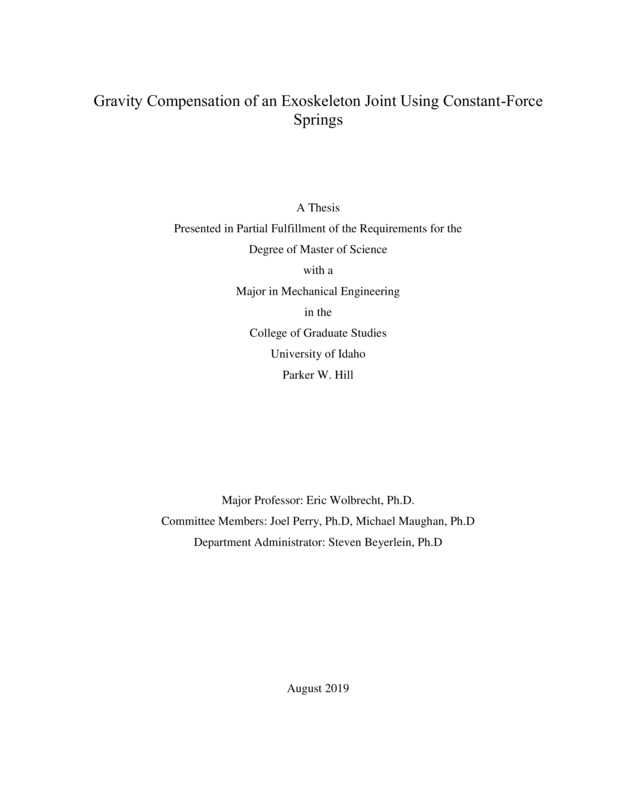Gravity Compensation of an Exoskeleton Joint Using Constant-Force Springs
Hill, Parker Wallace. (2019-08). Gravity Compensation of an Exoskeleton Joint Using Constant-Force Springs. Theses and Dissertations Collection, University of Idaho Library Digital Collections. https://www.lib.uidaho.edu/digital/etd/items/hill_idaho_0089n_11653.html
- Title:
- Gravity Compensation of an Exoskeleton Joint Using Constant-Force Springs
- Author:
- Hill, Parker Wallace
- Date:
- 2019-08
- Embargo Remove Date:
- 2022-02-06
- Program:
- Mechanical Engineering
- Subject Category:
- Mechanical engineering
- Abstract:
-
Stroke is one of the leading causes of impairment in the world. Many of those who have suffered a stroke experience long-term loss of upper-limb function as a result. BLUE SABINO is an exoskeleton device being developed at the University of Idaho to help assess these patients and aid in their rehabilitation. One of the central design challenges with exoskeletons is limiting the overall weight of the device. Motors used in actuation of these devices are often oversized to allow for gravity compensation and the creation of torques that facilitate patient movements. However, if the torques required for gravity compensation are achieved through passive elastic elements, the motor and other upstream components can be lighter, potentially greatly reducing the overall weight of the device. In this paper, constant-force springs are investigated as a method of generating a constant offsetting torque to compensate for gravity. In experimental testing of multiple mounting configurations of constant-force springs (single, back-to-back, double-wrapped), the force output fluctuated less than 8.6% over 180° of wrapping, with friction values below 2.6%, validating the viability of constant-force springs for this application. The results suggest that when using multiple springs, the back-to-back configuration provides a simpler implementation with better force consistency while the double-wrapped configuration adds less friction to the system. With these results, a mechanism was created to provide a torque of 35 ± 0.7 N-m to joint 3 of the BLUE SABINO exoskeleton at all orientations of joints 1, 2, and 3 of the exoskeleton to compensate for gravity.
- Description:
- masters, M.S., Mechanical Engineering -- University of Idaho - College of Graduate Studies, 2019-08
- Major Professor:
- Wolbrecht, Eric T
- Committee:
- Perry, Joel C; Maughan, Michael R
- Defense Date:
- 2019-08
- Identifier:
- Hill_idaho_0089N_11653
- Type:
- Text
- Format Original:
- Format:
- application/pdf
- Rights:
- In Copyright - Educational Use Permitted. For more information, please contact University of Idaho Library Special Collections and Archives Department at libspec@uidaho.edu.
- Standardized Rights:
- http://rightsstatements.org/vocab/InC-EDU/1.0/

